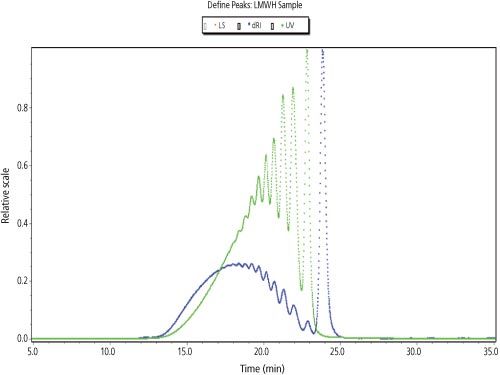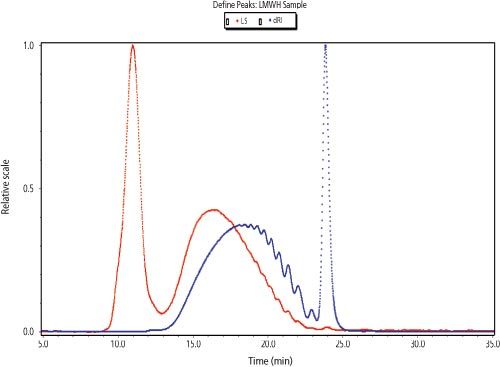Molecular Weight Determination of LMWH SEC–MALS vs. SEC–UV–RI
The Application Notebook
Low-molecular-weight heparins (LMWHs) are obtained by fractionation or depolymerization of natural heparins. They are defined as having a mass-average molecular weight of less than 8000 and for which at least 60% of the total weight has a molecular mass less than 8000.
Figure 1: Examples of UV and RI traces for an LMWH sample.

Size-exclusion chromatography (SEC) has been the most common way of measuring the molecular weight and molecular weight distributions of LMWHs by using the two most common detection technologies: ultraviolet (UV) coupled with refractive index (RI) detection. However, these detectors embody a relative method to determine molecular weights, requiring calibration standards. A newer, absolute method involves the use of multiâangle light scattering (MALS), which does not require any standards. The European Pharmacopeia (EP) monograph for LMWH specifies the use of the UV–RI detection method and provides a known calibration standard. Many laboratories around the world have adopted this method.
Figure 2: Examples of LS and RI traces for an LMWH sample.

We previously developed an SEC–MALS method and found it to be very suitable for the analysis of LMWHs. We have recently adopted the UV–RI method described in the EP monograph and compared the molecular weight results generated for LMWH using each detection type. The adopted method uses an Agilent LCâ1200 series HPLC, 0.2 M sodium sulphate pH 5.0 mobile phase, Tosoh TSK-gel G2000 SWxl column with Tosoh TSKâgel Guard SWxl, Waters 2487 dual wavelength UV detector, and Wyatt Optilab rEX refractive index detector. For MALS analysis, the UV detector was replaced with a Wyatt miniDAWN TREOS detector; all other method aspects remained the same.
The results indicated that both detection types are suitable and acceptable for the analysis of LMWHs. The molecular weight and distribution results generated using each detection type are comparable. This indicates that a SEC–MALS method could be adopted in place of the SEC–UV–RI method currently required by the EP monograph, and that it would result in less time because it obviates the need for calibration standards.
This note was graciously submitted by Lin Rao and John Beirne of Scientific Protein Laboratories LLC.

Wyatt Technology Corporation
6300 Hollister Avenue, Santa Barbara, California 93117, USA
Tel:+1 (805) 681 9009 fax: +1 (805) 681 0123
Website: www.wyatt.com

Understanding FDA Recommendations for N-Nitrosamine Impurity Levels
April 17th 2025We spoke with Josh Hoerner, general manager of Purisys, which specializes in a small volume custom synthesis and specialized controlled substance manufacturing, to gain his perspective on FDA’s recommendations for acceptable intake limits for N-nitrosamine impurities.
University of Rouen-Normandy Scientists Explore Eco-Friendly Sampling Approach for GC-HRMS
April 17th 2025Root exudates—substances secreted by living plant roots—are challenging to sample, as they are typically extracted using artificial devices and can vary widely in both quantity and composition across plant species.
Determining the Serum Proteomic Profile in Migraine Patients with LC–MS
April 17th 2025Researchers used liquid chromatography–mass spectrometry (LC–MS) in their proteomic analysis to compare the serum proteome of migraine patients with healthy controls and to identify differentially expressed proteins as potential migraine biomarkers.


















